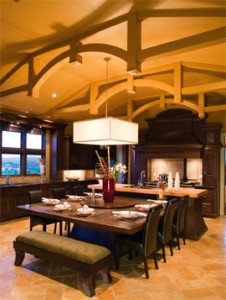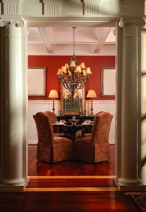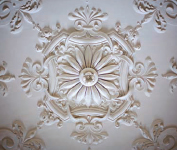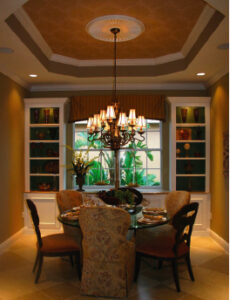SENSATIONAL CEILINGS Design Solutions Right Overhead

 Have you lost your appetite to eat in your dining room? Does your powder room lack pizzazz? Is your great room so vast that it’s not so, well…great? Consider this: The solution may be just over your head—literally. You can use your ceiling to add a unique touch to your décor; after all, it is a blank canvas, light fixtures notwithstanding, of unused space just crying for attention. And there is a host of easy options available that will provide big bang for the buck.
Have you lost your appetite to eat in your dining room? Does your powder room lack pizzazz? Is your great room so vast that it’s not so, well…great? Consider this: The solution may be just over your head—literally. You can use your ceiling to add a unique touch to your décor; after all, it is a blank canvas, light fixtures notwithstanding, of unused space just crying for attention. And there is a host of easy options available that will provide big bang for the buck.
Take your dining room, for example. If it’s blah and boxy, a ceiling treatment may add just the spice you need to give your room a figurative and literal lift. Certain ceiling treatments
can also mask structural or aesthetic challenges—think stains from previous [repaired] water damage—or help visually distinguish areas in large rooms that host multiple functions. And the best news of all: many treatments that were once crafted from heavy, rough-hewn boards or intricately designed plaster are now made of different types of plastics—resilient to the ravages of time, moisture and insects, and less expensive than the handcrafted artisanship previously required for rich ceiling treatments.
 Ceiling Medallions, Domes and Rings
Ceiling Medallions, Domes and Rings
Once found only in grand buildings of centuries past, ceiling medallions are now accessible to modern homeowners. They reached the height of popularity during the Renaissance, carefully crafted and meticulously carved from plaster or wood. Today such treatments, often made of lightweight resin, can add an elegant touch to a special space in your home. Think of creating a jewel-box effect—a tucked-away surprise—by surrounding a suspended light fixture in your powder room with a medallion, or giving your guests a reason to look up in your foyer with such a delightful treatment.
Ceiling medallions come in a vast range of sizes, from 4 inches in diameter on up. Experts suggest a simple formula to help choose the size that’s right for your room: Divide the square footage of your room by seven, and the resulting number represents the diameter in inches of the medallion you should consider. So if your room is 11 by 11, for example, you’d want to start by looking at circular treatments roughly 17 inches in diameter. Though your personal taste may push you toward something smaller or bolder, this formula gives you a great place to start.
Ceiling domes create a similar elegance but are concave or convex to create more of a three-dimensional effect. They can be recessed into the ceiling, either on their own or as part of a larger overall design. Ceiling rings are decorative sections of trim that can be fashioned around a focal point—a light fixture, medallion or dome, for example. And many of these treatments can be a simple, do-it-yourself task. Instant gratification!
 Tin Squares
Tin Squares
For some real textural interest, consider tin ceiling squares—metal plates embossed with intricate designs. They first became popular in American homes in the mid-19th century as a lower-cost alternative to the intricate plasterwork so popular in Europe. These ceiling tiles generally come in sizes ranging from six, twelve and 24-inch squares, and are crafted from aluminum alloy, plastic or steel. Experts suggest that if you wish to paint the tiles, you should do so before installation, using a high-gloss oil-based paint for best results. Embossed wallpaper made to look like tin squares is another great option.
Crown Molding
Crown molding is one of the easiest and most popular treatments for ceilings in homes both old and new. It can be used simply and sparingly in widths of only a few inches, stacked in a variety of widths, or wide and imposing, painted to a glossy sheen. Another interesting use for rooms with high ceilings is to incorporate molding where the ceiling meets the wall, then leave a space, then install a row of smaller molding a few inches down the wall. Moldings come in a variety of designs, including those with interesting patterns like dentil molding. Think of this treatment as a frame for the ceiling, a final polish for a finished room.
 Tray and Coffered Ceilings
Tray and Coffered Ceilings
A tray ceiling looks like just what it sounds like—an inverted tray. You can really have fun by using different paint treatments on the ceiling inside the tray, as well as the soffit around it. Worried that your ceilings are too low for a tray ceiling? Think of it this way: A little architectural interest will draw the eye up to the center of the ceiling and make it seem higher than it really is.
To really make an architectural statement, consider a coffered ceiling—a grid of boxes created with a series of perpendicular beams. Each box can be framed in a special trim, and painted or paneled with wood or beadboard.
Beams
Exposed ceiling beams evoke old world charm and rustic coziness. If you are building or remodeling a newer home, you can recreate this look by incorporating repurposed wood beams on your ceiling or even the newer lightweight urethane beams, which can be faux finished to mimic that old world craftsmanship.
Painted Treatments
Perhaps the easiest pop to pull off is the painted ceiling treatment. Have your paint retailer add a drop of blue to the old faithful “ceiling white” to add some sky-like softness to your ceiling. Go for the gold with a metallic paint, maybe applied with a special brush technique, or even consider a mural or trompe l’oeil treatment to fool the eye into thinking the ceiling is higher than it actually is.
Whether starting from scratch building a new home, or jazzing up the ceilings you already have, consider these ideas for your home. These are just a few treatments that will lift your rooms and lift your spirits. You’ll be looking at your ceilings—and your home—in a whole new way.






